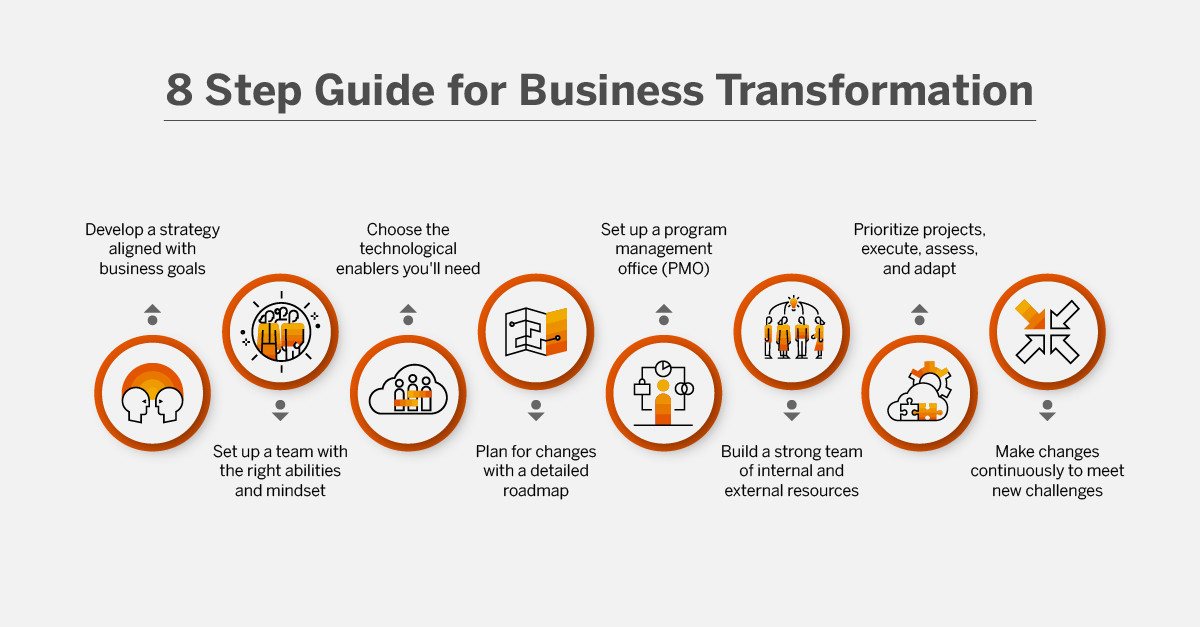Organizational dependence on IT systems has greatly increased in recent years, with enterprise technology itself changing drastically. In today’s digital-first world, business transformation is non-negotiable for organizations looking to sustain and win. However, research says that almost 70 percent of such corporate transformation efforts are bound to fail. The number is worrying, considering that a company’s profitability and even survival might be riding on the success of such an initiative.

So, what can be done to ensure an accelerated and successful business transformation journey? A wise step would be to learn from others. This is why SaaS models and the core principles behind them can offer a lesson or two. From following an organized way of executing a process to keeping the customer at the center of all actions, a SaaS company offers key tips for an effective digital transformation strategy. Here are some of them:
Taking a Customer-centric Approach
Many businesses have identified themselves in the past by the items or services they provide, rather than by the problems they address for consumers. A product-centric company is primarily concerned with product superiority, influenced by research and technology. Today, ‘as-a-service’ business models, which bucked even the recent pandemic-induced slowdown, are becoming popular. They function on the concept of ‘servitization’, a shift from a product focus to a service focus.
Thus, a company’s business transformation efforts should have a customer-centric strategy from the very start. This strategy should focus on a digital business model that leads to linked, coherent customer-centric experiences across business divisions. Companies that choose to adopt this new paradigm might need to change how they operate and how their functions interact. Real-time technology, such as business management software, can be used to achieve this.
Weaving in Flexibility into all Processes
Flexible consumption models, the foundation of SaaS companies, have challenged the rigid usage and billing models seen in traditional companies. Similarly, a company attempting business transformation should focus on agility in its processes and methods.
As with any complicated project, obstacles are bound to arise. From managing organizational and procedural changes to dealing with technical obstacles like data migration, transformation initiatives are notoriously difficult. Developing a flexible strategy enables the team to respond to changes as they arise, minimizing potential disruptions.
Following a unique, step-by-step Approach
Implementing a SaaS model requires a carefully thought-out plan that is customized according to the business’s unique needs and requirements. A one-size-fits-all approach does not work; the client and the vendor need to understand internal processes, expectations, goals, and timelines. Similarly, it’s critical to devise a business transformation strategy that bridges the gap between strategy and execution. Since no two companies are alike, every business transformation project needs a customized roadmap.
Step-by-step guide for Business Transformation
Deploying technology just for the sake of it is not an ideal way to transform an organization. Leaders need to make the connection between tech-based initiatives and their own business goals. This needs to be complemented by a phased roadmap. Having clear and concrete objectives, creating new business models and adopting efficient operational processes are some of the steps that this roadmap must have.
- Develop a strategy aligned with business goals –
The first and important step that needs to be taken by an organization is to have a vision about what business transformation can do, and thoroughly understand the outcome of such transformation. Project managers are under a lot of pressure to achieve speedy results. As a result, project plans jump into scoping technical needs, without devoting enough time to align business drivers and desired results. A proper strategy aligned to overall business goals is needed. This needs to be shared with key stakeholders and employees. To start building this strategy, you need to identify the right people and processes required to accelerate the business transformation process.
- Set up the right team –
The importance of early stakeholder involvement in developing a single, clear vision cannot be overstated. Executive buy-in is becoming increasingly crucial to the success of digital transformations, and as a result, participation committees are growing. To put your strategy into action, you’ll need to put together a team with the right abilities and mindset. Either a leadership committee or a designated leader will have to lead the project. They should take responsibility for the completion of the business transformation process smoothly within the pre-defined time and allocated budget. The core focus while appointing the leader should be experience and skill set. Usually, the CEO and CFO of a company take responsibility for this role. In some cases, a dedicated transformation director is appointed.
- Choose the technological enablers you’ll need
IoT, analytics, cloud, virtual reality, and artificial intelligence are all critical enablers for a successful digital transformation. Organizations should conduct research to determine which enabler is the greatest fit for their needs. Open-source technologies can be a powerful enabler for businesses.
- Plan for changes –
Identifying goals and outcomes is not the only draft required for business transformation. You need to expand the approach and make a detailed roadmap with all the essential changes that need to be carried out at various levels by various people. These changes – whether operational, managerial or cultural- can be divided into sub-projects with their dedicated objectives, timeframes and budgets. A set of business analytics tools can help get the structured data required to compose a plan.
- Set up of program management office (PMO) –
With this, the job of the transformation director or project leader becomes easier and streamlined. Through this dedicated department, they can monitor all processes, people and changes at various levels. This helps keep the business transformation on track.
- Build a strong team of internal and external resources –
At each level of the business transformation, you need to have the right set of resources, including the workforce required to carry out the processes. Many transitions are hampered by a scarcity of digital talent. Even if ideal candidates can be found for reasonable pay, most CIOs don’t have the funding to hire more full-time personnel. Organizations can bring in external resources with solid knowledge of the sector in which the business operates. For faster results, create teams with mixed resources consisting of both internal talent and outsourced talent for a collaborative approach.
- Execute, assess, adapt –
The scope, resources, and ROI of any digital endeavor will vary. Prioritize projects according to their importance, impact, and projected effort. Start with simple projects with essential features to test the digital solution’s viability. Allow employees to ask inquiries and provide comments. Throughout the process, organizations should encourage their teams to experiment with and test new technologies. Measure the impact.
- Make changes continuously –
Throughout this business transformation process, which can take months or years, the PMO should consistently refer to the implementation plan prepared. If new challenges are cropping up during the execution of the transformation, the office needs to effect changes to adapt to the current scenarios for better results. Even after the transformation process is over, the organization should welcome changes and support the integration of newer systems.

Best Practices to Speed up the Business Transformation Process
By following best practices for your digital transformation framework, companies can begin to enhance their odds of effectively implementing digital improvements.
- Prepare a structured playbook for transformation –
To ensure that the process of business transformation stays systematic and organized, you can maintain a playbook. This playbook will provide visibility to all stakeholders about the goals and expected outcomes, while building a step-by-step process for the program itself. Starting small with lesser complex projects will help to assess the feasibility and success rate of the transformation. While monitoring this impact, business management software will provide able assistance, and various business analytics tools will let you know areas that need attention.
- Make small and thoughtful investments –
Instead of diverting your focus with multitasking, it is better to segregate the entire process and start with small investments. This will ensure consistency and gradual productivity in the process of business transformation. If the whole process of transforming seems long and exhaustive, you can start with a small project, which requires minimum effort, and then draft an enterprise-wide strategy.
- Focus on metrics –
Data and analytics are being used as competitive weapons by leading firms across all industries. Use data to determine which aspects of your business and customer journey need to be improved. Rather than relying on traditional benchmarks and measurements, look at areas such as user engagement, risk factors, scope of transformation etc.
In conclusion
For a successful and quick digital transition, businesses must examine all of the best practices listed above. Like any other technology installation, total organization-wide transformation effort necessitates that company leaders set goals, provide staff with the tools they need, and keep customers and partners in mind at all times.



